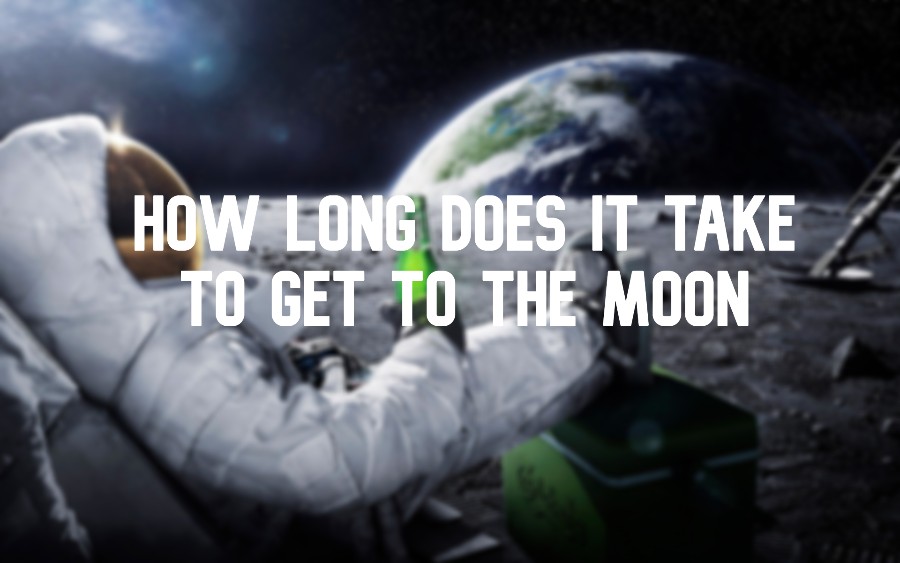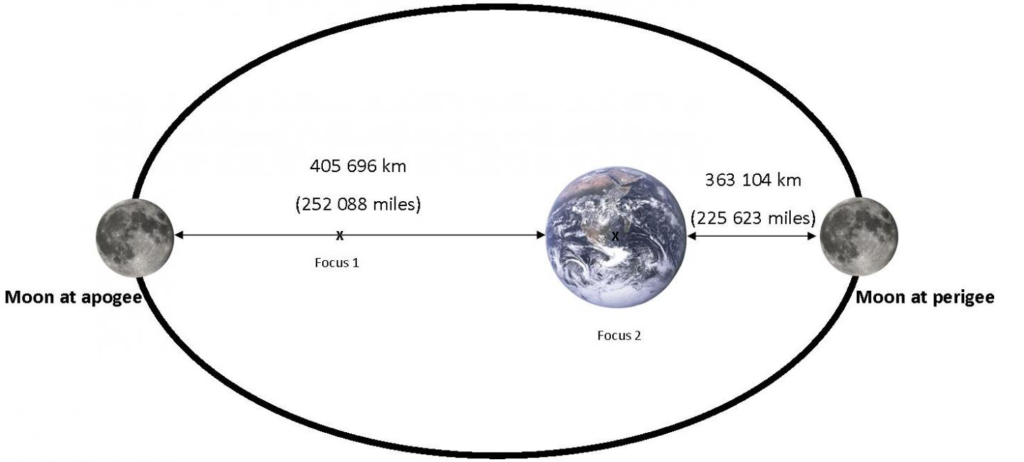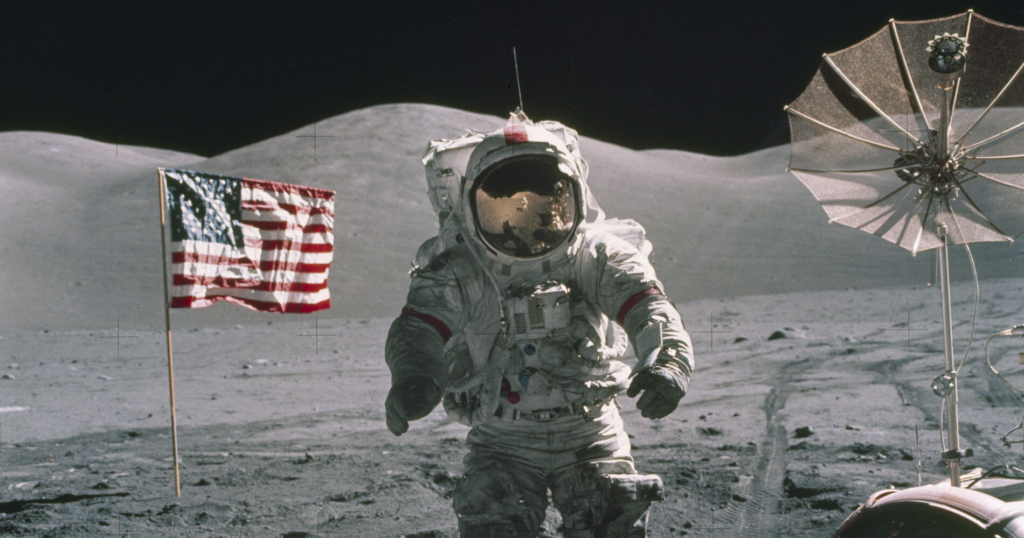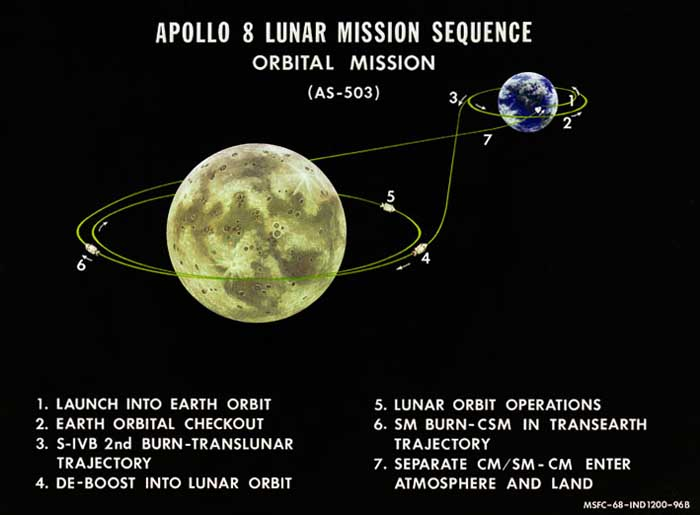How long does it take to travel to the Moon?
4th Jul 2022
The bright scattering of stars and planets in the night sky have always attracted humanity. But the Moon fascinated people most of all, hanging over the horizon either as a large yellow crescent or as if it were a suddenly dimmed sun. People worshipped the moon, made sacrifices to it, composed songs, and wrote treatises about it.
History tells us that even the Sumerians, who lived between 4500BC and 1900BC, sang of the moon god, and the ancient Greeks were the first to study the moon using a scientific approach. The advent of the first telescope in the 16th century made it possible to observe the Moon up close, but only the invention of the first rockets in the 20th century and the great space race that followed made flights to the Moon possible.
Why does the Moon seem so big to us compared to other celestial bodies? The answer is simple. It is the closest one to Earth, so it became the first tangible goal on humanity’s path to the stars. From 1969 to 1972, American astronauts landed on the Moon’s surface six times and today they are going to repeat and strengthen this achievement. In anticipation of the new Artemis lunar mission, we decided to tell you how long it takes to get to the Moon and what does it depend on?
How many miles is it from earth to the moon?

Back in the 2nd century BC, the ancient Greek astronomer Hipparchus determined that the average distance to the Moon is approximately 30 Earth diameters or 237 miles. Modern calculations have given a more accurate figure — 238,900 miles.
But why are we talking about “average” distance? The thing is, the Moon revolves around the Earth in an elliptical orbit, which is why its distance from the Earth is constantly changing. At perigee (the closest point of the lunar orbit to Earth) it is 221,500 miles (28.5 Earth diameters), and at apogee (the most distant point), 252,700 miles (almost 32 Earth diameters).
To understand how far this is, let’s imagine that we travel this distance in ordinary terrestrial vehicles.
How long would it take to drive to the moon?
Travelling to the moon in a car at an average speed of 60 miles per hour would take about 4,000 hours or 5 and a half months. You will need the same amount of time, to travel from Glasgow to London and back 300 times. Travelling by train would take approximately the same time, but by plane, it would be much quicker — just 20 days.
Naturally, all these trips are impossible, since internal combustion engines cannot operate in space. Space flights require jet rocket engines that do not consume oxygen from the air, because, as you know, there is no oxygen in space. Then how long does it take a rocket to get to the moon? To answer this question, let’s first define speed.
How fast do you have to go when going to the moon?
To get to the Moon, a spacecraft needs to overcome the Earth’s gravity. For this, a rocket needs to travel at the second space speed, which is 7 miles / s or 25200 miles per hour. If the speed is lower, the earth’s gravity will simply pull the vehicle back.
So how long does it take to get to the moon in a rocket?
Knowing the distance from the Earth to the Moon and the speed necessary to travel this distance, it is not that difficult to determine how long does it take to fly to the Moon in a rocket. Divide 238,900 miles by 7 miles per second and you get an average travel time to the Moon of 9.5 hours. But this figure is far from accurate.
The result closest to it was recorded in 2006 in the unmanned mission New Horizons (8.5 hours); however, that probe did not fly to the Moon but went past it in the direction of Pluto. Vehicles that went directly to the Moon took much longer to travel the distance.
For example, the first spacecraft to reach the surface of the moon in 1959 took 35 hours to complete the journey. It was the Soviet unmanned automatic mission “Luna-2”, which landed on the Moon in the Sea of Rains area and left a pennant with the USSR’s coat of arms there. And the longest unmanned mission to the Moon was Smart-1 by ESA, launched in 2004. It took 1 year, 1 month, and 2 weeks to reach the Moon.
How long did it take humans to get to the moon?

The first manned flight to the Moon took place on December 21, 1968. The Americans were losing the space race to the Soviets, so they needed a program that would not only close the gap, but also help the US get ahead in this space race. This is how Apollo came to life. The fastest manned flight to the Moon so far is Apollo 8. The spacecraft entered the lunar orbit 69 hours 8 minutes after the launch, circled the moon 10 times in 20 hours, and went home.
And six months later, on July 20, 1969, the United States landed on the moon. Apollo 11 astronauts Neil Armstrong and Buzz Aldrin successfully landed on the Eagle lunar module and set foot on the surface of a natural satellite for the first time in human history. They set up a US flag at the landing site, placed a set of scientific instruments, and collected 22 kg of lunar soil samples. The exit from the lunar module took 2 hours and 31 minutes, and in total, the astronauts spent 21 hours and 36 minutes on the Moon. All this time, their actions were monitored by the third crew member, Michael Collins, who remained in the command module in the lunar orbit.
How long did it take Apollo 11 to get to the Moon?
Apollo 11 travelled to the moon for 3 days, or more precisely, 75 hours and 49 minutes. On entering the lunar orbit, the spacecraft made 13 circles around the moon before the lunar module undocked from the command module and began its descent. These manipulations took 27 hours.
Why does it take 3 days to get to the moon in manned spaceflight?
To answer this question, let’s look at what path a spacecraft must travel to get from the Earth to the Moon. In the picture below you can see the sequence of actions that Apollo 8 had to perform.
The picture below shows you the action sequence performed by Apollo 8:
- Launch into Earth orbit.
- Entering the transfer orbit (translunar injection).
- Entering the lunar orbit.
- Lunar orbit operations — circling, flying past, descending (depending on mission objectives).

To carry out all these manoeuvres, the spacecraft needs energy. If there is not enough power, the mission will fail. To prevent this from happening, one needs to correctly calculate the spacecraft’s flight path (orbit). Besides technical characteristics (spacecraft mass, engine thrust), the calculation must take into account the impact of certain forces (gravity of the Earth, Moon, Sun, etc.). These are the so-called gravitational losses — changes in the spacecraft’s speed to perform orbital manoeuvres, or in other words, the cost of keeping the vehicle in the gravitational field.
The Apollo missions used a minimum-energy trajectory in which a spacecraft travelling away from the Earth slowed to a near-stop before descending to the Moon under the force of its gravity. That’s why the time to get to the Moon took 3 days instead of 35 hours as was the case of Luna-2. To reach the Moon faster, one would need to ignite the engines more often (or keep them running longer), which means burning more fuel — at first for acceleration, and then, for slowing down and soft landing, since there is no atmosphere on the Moon that could slow down the fall.
In the case of an unmanned mission, everything is much simpler. The spacecraft does not need to be equipped with a life support system and a habitation module. It is smaller and lighter, so it does not require a powerful rocket to launch it into orbit, which means it consumes less energy to overcome gravitational losses. Besides, a robotic mission does not always need to be brought back to Earth, and the human error factor, which may require additional manoeuvres, is eliminated.
How many flights to the moon were there?
Statistics report more than a hundred attempts to fly to the moon, but about half of them never reached the goal. At the end of the article, you will find a table of all successful crewed and uncrewed missions to the Moon.
How long would it take to get to the moon nowadays?
Despite the rapid breakthrough of the space industry in the 21st century, humanity has not yet returned to the moon. It’s still very expensive — just think about the scale. The cost of launching one super-heavy Saturn V rocket, built specifically for Apollo missions, was about $3.2 billion ($1 billion in 2020). This colossus reached a height of 110 m, weighed 5 thousand tons and burned 2000 tons of fuel in one flight! From 1967 to 1972, Saturn made 12 Apollo launches, after which the program was cancelled due to high costs and low scientific value.
Since then, only robotic missions have been sent to the Moon, and the colonization of the satellite is considered only an intermediate stage for the colonization of Mars. This is the objective for a new NASA Artemis lunar program, designed for the next 10 years. But first, NASA wants to wait until the leading aerospace giants Space X, ULA, Northrop Grumman, and Boeing complete the construction of new, more economical, and reliable rockets — Starship and SLS Orion.
Before this happens, there is no sense to talk about reducing travel time to the Moon. After all, it is still necessary to burn a lot of expensive fuel, so it is cheaper to equip a manned spacecraft with an additional supply of oxygen, and food, and fly the old-fashioned way — in 3-4 days.
How long did it take to get to the Moon?
Let’s take a look at the manned and unmanned Moon missions that took place1959-2020.
|
Spacecraft |
Launch date |
Flight duration to the Moon (orbiting or landing) |
Carrier rocket |
Operator |
Mission type |
|
Luna 2 |
12 Sept 1959 |
35 hours |
Luna |
OKB-1 |
Impactor |
|
Successful impact at 21:02 on 14 September 1959. First spacecraft to reach lunar surface. |
|||||
|
Luna 3 |
4 Oct 1959 |
3 days |
Luna |
OKB-1 |
Flyby |
|
Returned first images of the far side of the Moon. |
|||||
|
Ranger 7 |
28 July 1964 |
2 days |
Atlas LV-3 Agena-B |
NASA |
Impactor |
|
Impacted on 30 July 1964 at 13:25:48 UTC. |
|||||
|
Ranger 8 |
17 Feb 1965 |
3 days |
Atlas LV-3 Agena-B |
NASA |
Impactor |
|
Impacted on 20 February 1965 at 09:57:37 UTC. |
|||||
|
Ranger 9 |
21 March 1965 |
3 days |
Atlas LV-3 Agena-B |
NASA |
Impactor |
|
Impacted on 24 March 1965 at 14:08:20 UTC. |
|||||
|
Zond 3 |
18 July 1965 |
33 hours |
Molniya |
Lavochkin |
Flyby |
|
Flew past the Moon on 20 July 1965 at a distance of 9,200 kilometres (5,700 mi). Conducted technology demonstration for future planetary missions. |
|||||
|
Luna 9 |
31 Jan 1966 |
3 days |
Molniya-M |
Lavochkin |
Lander |
|
First spacecraft to land successfully on the Moon. Touchdown on 3 February 1966 at 18:45:30 UTC. Returned data until 6 February at 22:55 UTC. |
|||||
|
Luna 10 |
31 March 1966 |
4 days |
Molniya-M |
Lavochkin |
Orbiter |
|
Entered orbit at 18:44 UTC on 3 April 1966, becoming the first spacecraft to orbit the Moon. Continued to return data until 30 May. |
|||||
|
Surveyor 1 |
30 May 1966 |
65 hours |
Atlas LV-3C Centaur-D |
NASA |
Lander |
|
Landed in Oceanus Procellarum on 2 June 1966 at 06:17:36 UTC. Returned data until loss of power on 13 July. |
|||||
|
Luna 12 |
22 Oct 1966 |
3 days |
Molniya-M |
Lavochkin |
Orbiter |
|
Entered orbit on 25 October 1966 and returned data until 19 January 1967. Completed photography mission intended for Luna 11. |
|||||
|
Lunar Orbiter 2 |
6 Nov 1966 |
5 days |
Atlas SLV-3 Agena-D |
NASA |
Orbiter |
|
Entered orbit at about 19:51 UTC on 10 November 1966 to begin photographic mapping mission. Impacted on the far side of the lunar surface following deorbit burn on 11 October 1967 at end of mission. |
|||||
|
Luna 13 |
21 Dec 1966 |
3 days |
Molniya-M |
Lavochkin |
Lander |
|
Successfully landed in Oceanus Procellarum at 18:01 UTC on 24 December 1966. Returned images from the surface and studied the lunar soil. Operated until depletion of power at 06:31 UTC on 28 December. |
|||||
|
Lunar Orbiter 3 |
5 Feb 1967 |
3 days |
Atlas SLV-3 Agena-D |
NASA |
Orbiter |
|
Entered orbit at 21:54 UTC on 8 February 1967. Deorbited at end of mission and impacted the Moon on 9 October 1967. |
|||||
|
Surveyor 3 |
17 April 1967 |
3 days |
Atlas LV-3C Centaur-D |
NASA |
Lander |
|
Landed at 00:04 UTC on 20 April 1967 and operated until 3 May. Visited by Apollo 12 astronauts in 1969, with some parts removed for return to Earth. |
|||||
|
Lunar Orbiter 4 |
4 May 1967 |
4 days |
Atlas SLV-3 Agena-D |
NASA |
Orbiter |
|
Entered orbit at 21:54 UTC on 8 May 1967, operated until 17 July. Decayed from orbit, with lunar impact occurring on 6 October 1967. |
|||||
|
Explorer 35 |
19 July 1967 |
2 days |
Delta E1 |
NASA |
Orbiter |
|
Magnetospheric probe, studying the Moon and interplanetary space. Deactivated on 27 June 1973.Presumed to have impacted the Moon during the 1970s. |
|||||
|
Lunar Orbiter 5 |
1 August 1967 |
4 days |
Atlas SLV-3 Agena-D |
NASA |
Orbiter |
|
Final mission in the Lunar Orbiter series, entered selenocentric orbit on 5 August at 16:48 UTC and conducted a photographic survey until 18 August. Deorbited and impacted the Moon on 31 January 1968. |
|||||
|
Surveyor 5 |
8 Sep 1967 |
3 days |
Atlas SLV-3C Centaur-D |
NASA |
Lander |
|
Landed in Mare Tranquillitatis at 00:46:44 UTC on 11 September. Last signals received at 04:30 UTC on 17 December 1967. |
|||||
|
Surveyor 6 |
7 Nov 1967 |
3 days |
Atlas SLV-3C Centaur-D |
NASA |
Lander |
|
Landed in Sinus Medii at 01:01:04 UTC on 10 November. Made a brief flight from the lunar surface at 10:32 UTC on 17 November, followed by a second landing after traveling 2.4 meters (7 ft 10 in). Last contact at 19:14 UTC on 14 December. |
|||||
|
Surveyor 7 |
7 Jan 1968 |
65 hours |
Atlas SLV-3C Centaur-D |
NASA |
Lander |
|
Final Surveyor mission. Landed 29 kilometers (18 mi) from Tycho crater at 01:05:36 UTC on 10 January. Operated until 21 February 1968. |
|||||
|
Luna 14 |
7 April 1968 |
3 days |
Molniya-M |
Lavochkin |
Orbiter |
|
Tested communications for proposed crewed missions and studied the mass concentration of the Moon. Entered orbit on 10 April at 19:25 UTC. |
|||||
|
Zond 5 |
14 Sep 1968 |
3 days |
Proton-K/D |
Lavochkin |
Flyby, circled |
|
Two tortoises and other life forms on board a technology demonstration for planned crewed missions. Made a closest approach of 1,950 kilometers (1,210 mi) on 18 September, and circled the Moon before returning to Earth. Landed in the Indian Ocean on 21 September at 16:08 UTC, becoming the first Lunar spacecraft to be recovered successfully and carried the first Earth life to travel to and around the Moon. |
|||||
|
Apollo 8 |
21 Dec 1968 |
69 hours 8 minutes |
Saturn V |
NASA |
Crewed orbiter |
|
First crewed mission to the Moon; entered orbit around the Moon with a four-minute burn beginning at 09:59:52 UTC on 24 December. Completed ten orbits of the Moon before returning to Earth with an engine burn at 06:10:16 UTC on 25 December. Landed in the Pacific Ocean at 15:51 UTC on 27 December. |
|||||
|
Apollo 10 |
18 May 1969 |
75 hours and 55 minutes |
Saturn V |
NASA |
Crewed orbiter |
|
Dress rehearsal for Apollo 11. Lunar Module with two astronauts on board descended to a distance of 14.326 kilometers (8.902 mi) above the lunar surface. |
|||||
|
Apollo 11 |
16 July 1969 |
75 hours 49 minutes |
Saturn V |
NASA |
Crewed orbiter/lander |
|
First crewed landing on the Moon. The Lunar Module Eagle landed at 20:17 UTC on 20 July 1969. |
|||||
|
Zond 7 |
7 August 1969 |
4 days |
Proton-K/D |
Lavochkin |
Flyby |
|
Technology demonstration for planned crewed missions. Lunar flyby on 10 August, with a closest approach of 1,200 kilometers (750 mi); returned to Earth and landed in Kazakhstan at 18:13 UTC on 14 August. |
|||||
|
Apollo 12 |
14 Nov 1969 |
83 hours 25 minutes |
Saturn V |
NASA |
Crewed orbiter/lander |
|
Second crewed lunar landing. |
|||||
|
Luna 16 |
12 Sep 1970 |
5 days |
Proton-K/D |
Lavochkin |
Sample return |
|
Zond 8 |
20 Oct 1970 |
4 days |
Proton-K/D |
Lavochkin |
Flyby |
|
Technology demonstration for planned crewed missions; returned to Earth successfully. |
|||||
|
Luna 17 |
10 Nov 1970 |
5 days |
Proton-K/D |
Lavochkin |
Lander/rover |
|
Deployed Lunokhod 1. |
|||||
|
Apollo 14 |
31 Jan 1971 |
81 hours 56 minutes |
Saturn V |
NASA |
Crewed orbiter/lander |
|
Third crewed lunar landing. |
|||||
|
Apollo 15 |
26 July 1971 |
78 hours 31 minutes |
Saturn V |
NASA |
Crewed orbiter/lander/rover |
|
Fourth crewed lunar landing, and first to use the Lunar Roving Vehicle. |
|||||
|
Luna 19 |
28 Sep 1971 |
4 days |
Proton-K |
Lavochkin |
Orbiter |
|
entered an orbit around the Moon on 2 October 1971 after two midcourse corrections on 29 September and 1 October. |
|||||
|
Luna 20 |
14 Feb 1972 |
4 days |
Proton-K |
Lavochkin |
Sample return |
|
Luna 20 soft landed on the Moon in a mountainous area known as the Terra Apollonius (or Apollonius highlands) near Mare Fecunditatis (Sea of Fertility), 120 km from where Luna 16 had landed. |
|||||
|
Apollo 16 |
16 April 1972 |
74 hours 28 minutes |
Saturn V |
NASA |
Crewed orbiter/lander/rover |
|
Fifth crewed lunar landing. |
|||||
|
Apollo 17 |
7 Dec 1972 |
86 hours 14 minutes |
Saturn V |
NASA |
Crewed orbiter/lander/rover |
|
Sixth and last crewed lunar landing and last use of the Lunar Roving Vehicle; the orbiting command module included five mice. |
|||||
|
Luna 21 |
8 Jan 1973 |
4 days |
Proton-K |
Lavochkin |
Lander/rover |
|
Deployed Lunokhod 2. |
|||||
|
Explorer 49 |
10 June 1973 |
5 days |
Delta 1913 |
NASA |
Orbiter |
|
Radio astronomy spacecraft, operated in selenocentric orbit to avoid interference from terrestrial radio sources. |
|||||
|
Luna 22 |
29 May 1974 |
4 days |
Proton-K/D |
Lavochkin |
Orbiter |
|
Inserted into a circular lunar orbit on 2 June 1974 |
|||||
|
Luna 24 |
9 August 1976 |
3 days |
Proton-K/D |
Lavochkin |
Sample return |
|
Final mission of the Luna programme. Entered orbit on 11 August 1976 and landed in Mare Crisium at 16:36 UTC on 18 August. Sample capsule launched at 05:25 UTC on 19 August and recovered 96 +1⁄2 hours later. Returned 170.1 grams (6.00 oz) of lunar regolith. |
|||||
|
Clementine |
25 Jan 1994 |
25 days |
Titan II (23)G Star-37FM |
USAF/NASA |
Orbiter |
|
Completed Lunar objectives successfully; failed following departure from selenocentric orbit. |
|||||
|
Lunar Prospector |
7 Jan 1998 |
4 days |
Athena II |
NASA |
Orbiter |
|
The mission ended on July 31, 1999 |
|||||
|
SMART-1 |
27 Sept 2003 |
1 year 1 month and two weeks |
Ariane 5G |
ESA |
Orbiter |
|
Impacted moon in USGS quadrangle LQ26 at end of mission on 3 September 2006. |
|||||
|
SELENE |
14 Sept 2007 |
18 days |
H-IIA 2022 |
JAXA |
Orbiter |
|
Deployed Okina and Ouna satellites. Kaguya and Okina impacted the Moon at the end of mission.Ouna completed operations on 29 June 2009 but remains in selenocentric orbit. |
|||||
|
Chang’e 1 |
24 Oct 2007 |
12 days |
Long March 3A |
CNSA |
Orbiter |
|
Impacted Moon in USGS quadrangle LQ21 on 1 March 2009, at end of mission. |
|||||
|
Chandrayaan-1 |
22 Oct 2008 |
17 days |
PSLV-XL |
ISRO |
Orbiter |
|
Succeeded through mission. Terminated in 2009, remains in selenocentric orbit; discovered water ice on the Moon. Moon Impact Probe successfully impacted Moon in USGS quadrangle LQ30 on 14 November 2008. |
|||||
|
Lunar Reconnaissance Orbiter |
18 June 2009 |
5 days |
Atlas V 401 |
NASA |
Orbiter |
|
Entered orbit on June 23, 2009 |
|||||
|
LCROSS |
18 June 2009 |
5 days |
Atlas V 401 |
NASA |
Impactor |
|
Observed impact of Centaur upper stage that launched it and LRO, then impacted itself. Impacts in USGS quadrangle LQ30. |
|||||
|
Chang’e 2 |
1 Oct 2010 |
4 days 16 hours |
Long March 3C |
CNSA |
Orbiter |
|
Following completion of a six month Lunar mission, departed selenocentric orbit for Earth–Sun L2 Lagrangian point;subsequently flew by asteroid 4179 Toutatis. |
|||||
|
Ebb (Grail) |
10 Sept 2011 |
3 month and 20 days |
Delta II 7920H |
NASA |
Orbiter |
|
Part of the Gravity Recovery and Interior Laboratory, impacted the Moon in USGS quadrangle LQ01 on 17 December 2012 at end of mission. |
|||||
|
Flow (Grail) |
10 Sept 2011 |
3 month and 22 days |
Delta II 7920H |
NASA |
Orbiter |
|
Part of the Gravity Recovery and Interior Laboratory, impacted the Moon in USGS quadrangle LQ01 on 17 December 2012 at end of mission. |
|||||
|
LADEE |
7 Sept 2013 |
30 days |
Minotaur V |
NASA |
Orbiter |
|
Mission ended on 18 April 2014, when the spacecraft’s controllers intentionally crashed LADEE into the far side of the Moon. |
|||||
|
Chang’e 3 |
1 Dec 2013 |
5 days |
Long March 3B |
CNSA |
Lander |
|
Entered orbit on 6 December 2013 with landing at 13:12 UTC on 14 December. |
|||||
|
Manfred Memorial Moon Mission |
23 Oct 2014 |
5 days |
Long March 3C |
LuxSpace |
Flyby / Impactor (post mission) |
|
Attached to the third stage of CZ-3C used to launch Chang’e 5-T1. Impacted the Moon on 4 March 2022. |
|||||
|
Chang’e 4 |
7 Dec 2018 |
5 days |
Long March 3B |
CNSA |
Lander/rover |
|
First spacecraft to soft land on the far side of the Moon (South Pole–Aitken basin). Landed 3 January 2019 and deployed the Yutu-2 rover. |
|||||
|
Chandrayaan-2 |
22 July 2019 |
29 days |
GSLV Mk III |
ISRO |
Orbiter |
|
Entered orbit on 20 August 2019. Lander separated from the orbiter but crashed during a landing attempt on 6 September 2019, attributed to a software glitch. Orbiter remained operational. |
|||||
|
Chang’e 5 |
23 Nov 2020 |
5 days |
Long March 5 |
CNSA |
Lander/sample return/flyby |
|
First lunar sample return mission from China, which returned 1,731 g (61.1 oz) of lunar samples on 16 December 2020. The orbiter received a mission extension and is currently in a distant retrograde orbit (DRO) of the Moon. |
|||||
![Beauty of the Pink Moon And Lyrid Meteor Shower in This Week’s Best Astrophotos [19-26 April] Beauty of the Pink Moon And Lyrid Meteor Shower in This Week’s Best Astrophotos [19-26 April]](https://orbitaltoday.com/wp-content/uploads/2024/04/Pink-Moon-is-on-its-way-above-the-mountains-1-300x300.jpg)





Thank you for your comment! It will be visible on the site after moderation.